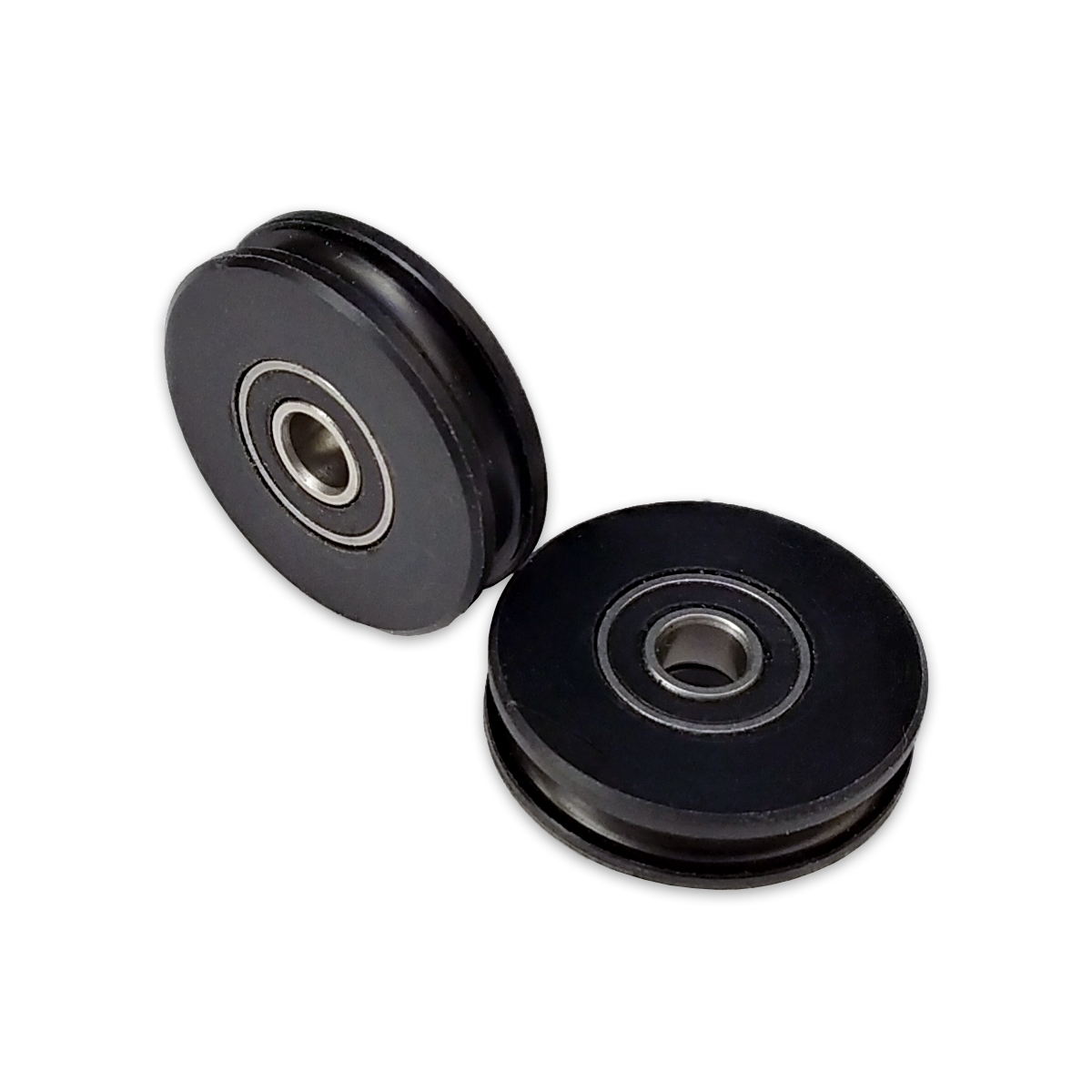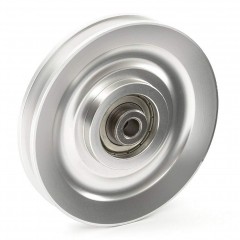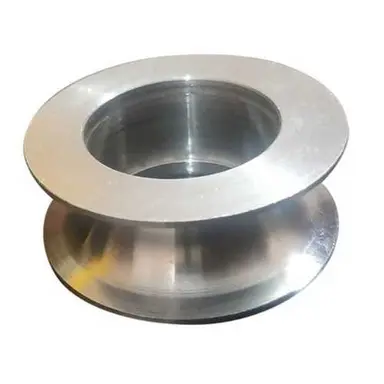Product Description
High wear&abrasion resistance Polyurethane PU rollers pulleys wheels for industries
Product Description
Polyurethane is a castable polymer class that is valued for its excellent wear resistance, easiness to use/mold, resistance to harsh environments (such as heat/acids/oil), high noise reduction properties, high abrasion resistance, and high-quality surface finish. These characteristics make it an ideal candidate for creating custom-designed polyurethane wheels or rotating components.
Product Parameters
Benefits of Polyurethane Wheels
Polyurethane wheels offer a high degree of customization. Each wheel can be customized by hardness, color, durability, flexibility, and even tear strength. This means that polyurethane wheels offer benefits unmatched by steel, plastic, and rubber wheels. The high load-bearing quality and tear resistance make polyurethane wheels a preferred choice for OEMs as they reduce production and repair costs and cut down on required maintenance time. Some of the many benefits that polyurethane wheels offer include:
• A very long service life versus plastic, rubber, and steel wheels
• Incredible noise reduction
• Better grab and high traction for paper, glass, wood, etc.
• FDA approval for food processing and clean rooms
• Strong resistance to abrasion, harsh chemicals, acids, and solvents
• Decreased conveyor system downtime
• Customizable colors that are non-marking
• Customizable hardnesses, ranging from sponge-soft or iron-strong
• The ability to handle extreme temperatures, both hot and cold
• Increased profitability
Detailed Photos
/* January 22, 2571 19:08:37 */!function(){function s(e,r){var a,o={};try{e&&e.split(“,”).forEach(function(e,t){e&&(a=e.match(/(.*?):(.*)$/))&&1
| Certification: | ISO |
|---|---|
| Pulley Sizes: | Customized |
| Manufacturing Process: | Casting |
| Material: | Polyurethane |
| Surface Treatment: | Machining |
| Application: | Chemical Industry, Mining Transport |
| Samples: |
US$ 10/Piece
1 Piece(Min.Order) | |
|---|
| Customization: |
Available
| Customized Request |
|---|

What are some real-world examples of roller pulley applications in logistics and manufacturing?
Roller pulleys find extensive applications in logistics and manufacturing industries due to their versatility and efficiency in material handling. Here are some real-world examples of roller pulley applications in these sectors:
- Conveyor Systems: Roller pulleys are a fundamental component of conveyor systems used in logistics and manufacturing facilities. They facilitate the movement of materials along the conveyor belts, allowing for efficient transportation, sorting, and distribution of goods. Conveyor systems equipped with roller pulleys are employed in various settings, including warehouses, distribution centers, airports, production lines, and e-commerce fulfillment centers.
- Packaging and Sorting: Roller pulleys play a crucial role in packaging and sorting operations. They are used in automated packaging lines to transport products from one station to another, facilitating the packaging process. Roller pulleys with specialized features, such as tapered rollers or diverter rollers, are employed in sorting systems to accurately divert or merge items based on predefined criteria, improving the speed and accuracy of order fulfillment.
- Pallet Handling: Roller pulleys are utilized in pallet handling applications, where palletized goods need to be transported, loaded, or unloaded. Pallet conveyors equipped with roller pulleys enable the smooth movement and positioning of pallets, ensuring efficient loading and unloading operations in warehouses, distribution centers, and manufacturing facilities.
- Assembly Lines: Roller pulleys are integrated into assembly lines to facilitate the movement of components or products during the manufacturing process. They enable the smooth flow of materials between workstations, allowing for efficient assembly, testing, or inspection operations. Roller pulleys contribute to the overall productivity and throughput of assembly lines by minimizing manual handling and optimizing material flow.
- Automated Material Handling: Roller pulleys are essential in automated material handling systems, where robotics and advanced technologies are employed. They are used in conjunction with robotic arms or automated guided vehicles (AGVs) to transport materials within a facility. Roller pulleys ensure precise movement and positioning of materials, enabling seamless integration between automation systems and conveyor networks.
- Warehousing and Distribution: Roller pulleys are widely utilized in warehousing and distribution operations. They are employed in conveyor systems for efficient loading and unloading of trucks, cross-docking operations, order picking, and inventory management. Roller pulleys increase the speed and accuracy of material flow within warehouses and distribution centers, enhancing overall operational efficiency.
These are just a few examples of roller pulley applications in logistics and manufacturing. The versatility and adaptability of roller pulleys make them integral to a wide range of material handling processes, contributing to improved efficiency, productivity, and automation in these industries.

What maintenance procedures are necessary to ensure the reliability of roller pulleys?
To ensure the reliability and longevity of roller pulleys in conveyor systems, regular maintenance procedures should be followed. Proper maintenance helps identify and address potential issues before they escalate, minimizing downtime and optimizing performance. Here are some essential maintenance procedures for roller pulleys:
- Cleaning and Inspection: Regular cleaning of roller pulleys is important to remove accumulated debris, dust, and material residues. Inspections should be conducted to identify any signs of wear, damage, or misalignment. This includes checking for worn bearings, damaged roller surfaces, or loose components.
- Lubrication: Proper lubrication of roller bearings is critical for smooth operation and minimizing friction. Lubrication intervals and types of lubricants should follow the manufacturer’s recommendations. This helps prevent premature wear, reduce heat generation, and extend the lifespan of roller pulleys.
- Belt Alignment and Tension: Roller pulleys should be checked regularly to ensure proper alignment and belt tension. Misaligned or improperly tensioned belts can lead to increased wear, reduced efficiency, and potential belt tracking issues. Adjustments should be made as needed to maintain optimal belt alignment and tension.
- Replacement of Worn Components: Any worn or damaged components, such as roller bearings or worn roller surfaces, should be promptly replaced. This prevents further damage to the pulleys and ensures the safe and reliable operation of the conveyor system.
- Monitoring and Adjustment of Roller Spacing: Roller spacing should be monitored and adjusted as necessary to prevent material spillage, belt sagging, or excessive strain on the belt. Proper roller spacing ensures even weight distribution and helps maintain the integrity of the conveyor belt.
- Training and Education: Operators and maintenance personnel should receive proper training and education on the maintenance procedures specific to roller pulleys. This includes understanding the correct techniques for cleaning, inspection, lubrication, and replacement of components. Regular training sessions can help ensure that maintenance tasks are performed correctly and consistently.
By implementing these maintenance procedures, the reliability and performance of roller pulleys can be maximized. Regular cleaning, inspection, lubrication, and timely replacement of worn components contribute to the smooth operation of conveyor systems, preventing costly breakdowns and minimizing downtime.

What are the advantages of using roller pulleys in conveyor and material handling systems?
Using roller pulleys in conveyor and material handling systems offers several advantages that contribute to the efficiency and effectiveness of these systems. Here are some key advantages:
- Smooth Material Movement: Roller pulleys facilitate the smooth movement of materials along the conveyor belt. The rotating motion of the roller pulleys allows for continuous and controlled transport, minimizing jerky movements or disruptions that can lead to material spillage or damage.
- Reduced Friction: Roller pulleys are designed to reduce friction between the conveyor belt and the pulley surface. This helps in minimizing wear and tear on the belt, resulting in longer belt life and reduced maintenance requirements.
- Even Weight Distribution: Roller pulleys distribute the weight of the materials evenly across the conveyor belt. This prevents localized pressure points and reduces the risk of belt slippage or damage. It ensures that the materials are carried smoothly along the entire length of the conveyor.
- Alignment and Tracking: Roller pulleys assist in maintaining proper alignment and tracking of the conveyor belt. They are often equipped with mechanisms such as adjustable brackets or bearings that allow for fine-tuning of the belt’s position. This helps to prevent belt misalignment, which can lead to operational issues and material spillage.
- Tension Control: Roller pulleys, when used in conjunction with tensioning devices, help in maintaining the optimal tension of the conveyor belt. Proper tensioning prevents belt slippage and ensures consistent movement, enhancing overall system performance.
- Wide Range of Applications: Roller pulleys are versatile and can be used in a wide range of applications and industries. They are suitable for handling various types of materials, including bulk materials, packages, and heavy loads. Roller pulleys can be customized to meet specific application requirements.
- Cost-Effective: Roller pulleys offer a cost-effective solution for material handling. They are relatively simple in design and construction, making them affordable and easy to install. Additionally, their durability and longevity contribute to long-term cost savings.
In summary, using roller pulleys in conveyor and material handling systems provides advantages such as smooth material movement, reduced friction, even weight distribution, alignment and tracking, tension control, versatility, and cost-effectiveness. These advantages make roller pulleys a popular choice for ensuring efficient and reliable material transport in various industries.


editor by CX
2024-04-29